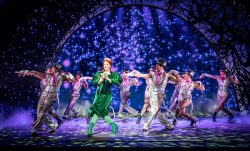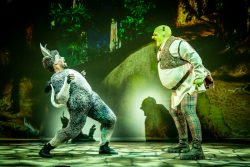 AUDIENCE tastes have changed greatly since the start of this century – the days when a successful US show, like How to Succeed in Business Without Really Trying, failed miserably in this country because they were too American have long gone.
AUDIENCE tastes have changed greatly since the start of this century – the days when a successful US show, like How to Succeed in Business Without Really Trying, failed miserably in this country because they were too American have long gone.
As a result, although the mainly British cast did not always capture the essential rhythm of dialogue and lyrics – written by Americans for American actors – in a manner to capture all the original humour, they created characters who were readily acceptable to the highly responsive audience. Their enthusiasm and energetic presentation having captured the audience, it was cheers all the way.
Jeanne Tessori’s score, which won the best original score award when the show opened on Broadway, is ready-made for picture-frame endings after each of the many ensemble numbers. The principals were all guaranteed a big ending and fulsome audience response thanks to the hard work and talents of 16 fiercely committed dancers, who swapped characters with the skills of a chameleon changing colour.
We know what colour Shrek is – green – but in the hands of Antony Lawrence he is perhaps a little too much of a Big Friendly Giant. We saw a lot of the sadness and vulnerability in the character, but I doubt that, even when out of sorts uttering a high-powered recorded bellow, he would have put the wind up any but the most nervous of the would-be inhabitance of his swamp.
 The love hate relationship with Joanne Clifton’s Princess Fiona worked well, vocally and dramatically. Her distinctive Fiona, determined to win every battle, bore little resemblance to the film’s dainty Princess, until the late realisation that Shrek loves her as a person, not just for her physical beauty.
The love hate relationship with Joanne Clifton’s Princess Fiona worked well, vocally and dramatically. Her distinctive Fiona, determined to win every battle, bore little resemblance to the film’s dainty Princess, until the late realisation that Shrek loves her as a person, not just for her physical beauty.
Tap-dancing with the Pied Piper (one of many fine characters to emerge from the ensemble) and the rats, underlined the fact that, whether or not you liked Joanne’s interpretation, she is a top quality all-rounder, actor, singer and dancer.
The Boston-trained Brandon Lee Sears had a head start when it came to drawing the best out of the American humour. Twisting his body into some wonderful poses and delivering the New York-style dialogue with pace and good timing, he didn’t miss a trick in his portrait of the Donkey. Matching him all the way with much less ammunition was Cherece Richard’s Dragon Lady. She made an impressive first entrance backed by the well manipulated fire-eating Dragon, and followed it up with powerfully delivered vocals and a natural stage presence that drew your attention to her every time she appeared.
This pair took full advantage of the show’s fine opportunities, particularly the comedy. James Gillan was left with scraps of humour as the egotistical villain, Lord Farqaad, as a mini-man on obviously false short legs was sacrificed on the altar of political correctness. For all Gillan’s skill and commitment, the casting of an actor approximately the same height as Princess Fiona was never going to generate as many laughs as the usual idea of sending one out to play the role on their knees.
Although well-staged with excellent use of video, there were moments when the changes did not dovetail exactly, and not every player synchronised lip movements perfectly with the additional taped vocal input. None of this bothered the audience who loved virtually every moment, which meant that these ebullient, fully-committed principals and ensemble received what their efforts deserved – a rousing final reception.
Photographs by Marc Brenner.
GRP